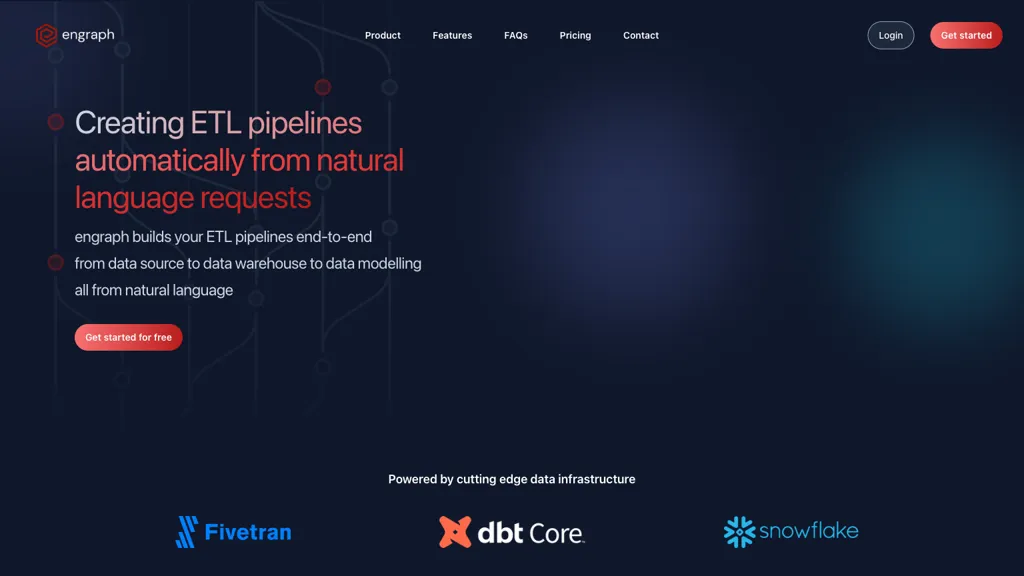What is Engraph?
Engraph is a top-notch, artificial intelligence-powered automation of ETL pipeline development. It offers a natural language interface that generates reusable dbt models for simplifying data transformation, allowing for seamless integration with over 340 data tools. Engraph provides collaboration among team members, access control, and on-premise deployment for enhanced security.
Key Features & Benefits Engraph
Engraph comes fully loaded with features that make it a stand-out choice for its users engaged in data engineering and analytics. Some major features and benefits of using it are listed below.
-
Automate ETL pipeline generation:
Less time is used in generating a pipeline, which reduces the chances of human errors. -
Generate reusable dbt models:
Reuse the data transformation models generated by Engraph in order to save a lot of time and minimize efforts. -
Effortless integrations:
Seamlessly connect to more than 340 data tools using prebuilt connectors. -
Team collaboration feature:
Enhance collaboration amongst team members in real-time collaboration with granular access control. -
Pipeline Monitoring:
Real-time quality checks on data will be enabled shortly.
In all, the above benefits bring enormous advantage by reducing manual coding, increasing workflow efficiencies and assurance of quality data by automation of processes.
Use Cases and Applications of Engraph
Engraph can also be used or applied in many uses such as:
-
Automation of complex ETL pipelines:
Utilize the natural language interface of Engraph and avoid manual coding, which will reduce development time and errors. Ensure seamless collaboration among team members in any data transformation project for effective communication and workflow. -
Data Transformation:
Apply transformations easily across multiple data tools, smoothly and seamlessly extracting, transforming, and loading data with ease.
Engraph yields huge benefits for industries such as finance, health, retail, and technology. It mainly provides services to people like data engineers, data analysts, and data scientists with its huge capabilities.
Using Engraph
It is very easy to use Engraph, following in mind its user-friendly interface, as mentioned here:
-
Registration and login:
One has to create an account and sign in with the details provided to reach the dashboard. -
Create a new project:
Create a new project and define the sources of your data. -
Generate ETL pipelines:
Through natural language commands, create ETL pipelines and reusable dbt models. -
Collaborate:
Invite other team members and grant appropriate access controls to start collaborating. -
Pipeline monitoring:
Coming soon, use real-time monitoring features to keep track of data quality.
Best practices include the regular review of generated models, transparency in communications among teams, and access controls for ensuring data security.
How Engraph Works
Engraph uses the latest AI algorithms in building automated ETL pipelines. Underlying Technology: The technology is based on NLP mechanisms for processing users’ commands and translating them into generated dbt models. These created models integrate with various data tools for different types of data transformation.
These are done in the following manner:
- User types commands in the natural language interface.
- Engraph interprets the commands using NLP algorithms.
- ETL pipelines and dbt models, based on the input, are created.
- Integrates the models with the user’s data tools for seamless data transformations.
Pros and Cons of Engraph
Like every tool, Engraph has its pros and cons:
-
Pros:
- Reduces manual coding efforts drastically.
- Enhances collaboration between teams through real-time capabilities.
- Extensive integrations with a wide variety of data tools.
-
Cons:
- Some of the future features, such as real-time monitoring, are yet unavailable.
- The freemium model may have limitations that users may have to upgrade to a paid plan.
Overall user feedback indicates that this is a very good tool in automating ETL processes and also in its integration capabilities.
Conclusion about Engraph
Engraph is, no doubt, one of the potent AI tools put to use for automating ETL pipelines. Key features are generation/reusability of dbt models and seamless integrations that bring in massive benefits for data engineers, analysts, and scientists. Although there is room for improvement—like real-time monitoring, for instance—the efficiency of the tool and its features contribute a great deal to collaboration across many industries.
With each new update, it’s going to get even stronger, and this makes Engraph a more alluring choice for the automation of data workflows.
Engraph FAQs
-
What is Engraph?
Engraph is an AI tool that develops ETL pipelines using a natural language interface and creates reusable dbt models. -
Who can use Engraph?
This can be used by data engineers, data analysts, or data scientists in various industries, such as finance, healthcare, and technology. -
What are Engraph pricing plans?
Engraph offers a Freemium pricing model and is further upgradeable to paid plans: Self-serve at $85/user/month, Startup at $170/user/month, and Enterprise – contact for pricing. -
What are some of the key features on offer from Engraph?
Among key features are the creation of automated ETL pipelines, reusable dbt model generation, seamless integrations with more than 340 data tools, and collaboration features with access controls. -
Is there a free version of Engraph?
Of course, Engraph has a free version with some limitations. At any time, users can change to a paid plan in order to have more features.










